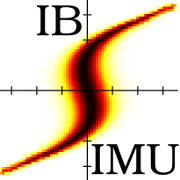Secondary electron emission
For creating secondary electrons you need a callback to process all ending trajetory calculations:
class SECallback : public TrajectoryEndCallback {
Geometry &_geom;
MTRandom _rand;
double _k;
double _theta;
public:
SECallback( Geometry &geom )
: _geom(geom), _rand(3) {
_k = 9.0;
_theta = 0.5;
_rand.set_transformation( 0, Gamma_Transformation( _k, _theta ) );
}
virtual ~SECallback() {}
virtual void operator()( ParticleBase *particle, class ParticleDataBase *pdb ) {
Particle3D *p3d = (Particle3D *)( particle );
Vec3D loc = p3d->location();
Vec3D vel = p3d->velocity();
double E = 0.5*p3d->m()*vel.ssqr()/CHARGE_E;
// Make secondaries based on location and energy
if( fabs(loc[0]) < 10.1e-3 && loc[1] > 0.0 &&
loc[2] > 34.9e-3 && loc[2] < 55.1e-3 && E > 1e3 ) {
// Get normal
Vec3D normal = _geom.surface_normal( loc );
// Adjust location off the surface
loc += 0.01*_geom.h()*normal;
// Randomize velocity and direction
double x[3];
_rand.get( x );
double mass = 1.0/1836.00;
double speed = sqrt( 2.0*x[0]*CHARGE_E/(mass*MASS_U) );
// Find tangents
Vec3D tang1 = normal.arb_perpendicular();
Vec3D tang2 = cross( normal, tang1 );
tang1.normalize();
tang2.normalize();
// Build velp in natural coordinates
double azm_angle = 2.0*M_PI*x[1];
double pol_angle = asin( sqrt(x[2]) );
Vec3D velp( speed*cos(pol_angle), speed*sin(pol_angle), 0.0 );
Transformation t;
t.rotate_x( azm_angle );
velp = t.transform_vector( velp );
// Convert to surface coordinates
Vec3D vel = velp[0]*normal + velp[1]*tang1 + velp[2]*tang2;
ParticleDataBase3D *pdb3d = (ParticleDataBase3D *)( pdb );
pdb3d->add_particle( p3d->IQ(), -1.0, mass, ParticleP3D( 0.0,
loc[0], vel[0],
loc[1], vel[1],
loc[2], vel[2] ) );
}
}
};
The callback needs to be set for the particledatabase:
SECallback secb( geom ); pdb.set_trajectory_end_callback( &secb );
